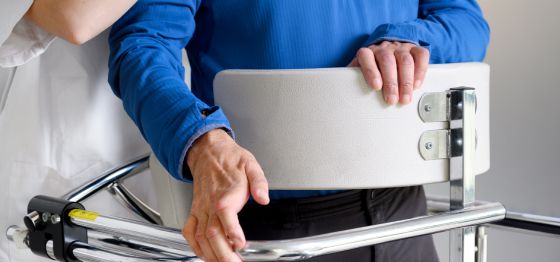From reduced sex drive and erectile dysfunction to depressed mood and fatigue, these typical symptoms may indicate low testosterone in men.1
Low testosterone, or male hypogonadism, is a condition when a man’s testicles don’t produce enough testosterone, the male sex hormone. Testicles are the gonads (sex organs) in people assigned male at birth (AMAB).2
Testosterone levels in adults AMAB naturally decline as they age.3 Other factors causing low testosterone, or “low-t,” include side effects from medication and other conditions, body fat and more. Read on to learn about symptoms of low testosterone, as well as treatment options.
The role of testosterone in health and well-being
The male hormone, testosterone, triggers development of male characteristics and is essential for sperm production (spermatogenesis). Testosterone levels are naturally much higher in people AMAB compared to people assigned female at birth.4
For people AMAB, testosterone helps to cultivate and manage:5
- Genitalia and sex organs.
- Sexual and reproductive function.
- Facial and body hair.
- Muscle strength and mass.
- Red blood cell production.
- Bone density.
- Feeling of well-being.
The hypothalamus control center of the brain and pituitary gland release hormones that travel to the gonads (testicles or ovaries) and stimulates the production of testosterone and sperm. Any issues with the testicles, hypothalamus or pituitary gland may cause male hypogonadism or low testosterone.6
Who is affected by low testosterone (male hypogonadism)?
Male hypogonadism is a medical condition that can affect people with testicles at any age from birth through adulthood.
Low testosterone is more likely to affect people who:7
- Are older.
- Are overweight with waist circumference over 40 inches for men and over 35 inches for women.8
- Are poorly managing Type 2 diabetes.
- Have chronic medical conditions, such as kidney dysfunction or cirrhosis of the liver.
- Have obstructive sleep apnea.
- Have human immunodeficiency virus or acquired immondeficiency syndrome (HIV/AIDS).
Testosterone levels spike during adolescence and early adulthood. Beginning at age 30 or 40, testosterone levels slowly decline—usually about 1% a year.9 Older men are advised to determine if a low testosterone level is occurring because of normal aging or due to hypogonadism disease.
Signs and symptoms of low testosterone
The symptoms for low testosterone vary greatly—especially depending on a person’s age.
What happens when a man’s testosterone is low? For adults AMAB, the signs and symptoms for low testosterone include:10
- Reduced sex drive and depressed mood.
- Shrinking testicles and erectile dysfunction.
- Loss of armpit and pubic hair.
- Low or zero sperm count (azoospermia), causing male infertility.
- Difficulties with concentration and memory.
- Increased body fat and enlarged male breast tissue (gynecomastia).
- Decrease in muscle strength and mass.
Causes of low testosterone
As a natural course of aging, starting around age 30 to 40, testosterone levels may start to slowly decrease. Other causes of low testosterone:11
- Side effects from medicine, such as from chemotherapy.
- Testicle trauma, prostate cancer or other cancer.
- Issues with glands in the brain—the hypothalamus and pituitary glands—that control hormone production.
- Reduced thyroid function.
- Too much body fat (obesity).
- Other disorders, chronic diseases, treatments or infection.
Male hypogonadism is a result of testicles not producing enough of the male sex hormone, testosterone. There are two types of male hypogonadism:12
- Primary male hypogonadism manifests because of a problem in the testicles and is also known as primary testicular failure.
- Secondary male hypogonadism occurs when there are issues with the hypothalamus or pituitary gland. The hypothalamus produces a gonadotropin-releasing hormone, which signals the pituitary gland to make a follicle-stimulating hormone (follicle-stimulating hormone (FSH)) and luteinizing hormone (luteinizing hormone (LH)). The luteinizing hormone then signals the testes to produce testosterone.
Diagnosing low testosterone
A physical exam is required to diagnose low testosterone. After reviewing symptoms and medical history, doctors will also perform multiple blood tests because levels can fluctuate daily.13
After a diagnosis, other tests may be recommended by the physician. For example, since low-t has the potential to speed bone loss, the doctor may recommend a bone density test for osteoporosis.14
Tests to diagnose low testosterone
These tests are used to confirm testosterone deficiency and determine the cause:15
- Total testosterone level blood test – Usually requiring 2 sample collections when testosterone levels are at their highest, between 8 a.m. and 10 a.m.
- Luteinizing hormone (LH) blood test – Determines if the cause of low testosterone is an issue with the pituitary gland.
- Prolactin blood test – Identifies issues with the pituitary gland or tumors if prolactin levels are high.
Treatments for low testosterone
To fix low testosterone, male hypogonadism is treated with testosterone replacement therapy in several forms:16
- Testosterone skin gels – One of the most common forms of testosterone treatment in the U.S., the gel is applied daily to clean, dry skin.
- Intramuscular testosterone injections – The patient or healthcare provider may administer injections into the muscle every 1 – 2 weeks. Long-acting testosterone are an option to be injected every 10 weeks. Additional options are subcutaneous injections.
- Testosterone patches – The patient applies the patches to the skin daily as directed. To avoid skin reactions, the patches are usually placed in different locations.
- Testosterone pellets – Every 3 – 6 months, a specialist implants the pellets under the skin. The pellets deliver long-term and consistent dosages of testosterone.
- Buccal testosterone tablets – The pills are sticky and applied to the patient’s gums twice daily, allowing testosterone to absorb quickly into the bloodstream.
- Testosterone nasal gel – The gel is applied into each nostril 3 times daily.
- Oral testosterone – Undecanoate, the pill form of testosterone, is prescribed for people with specific medical conditions such as Klinefelter syndrome or tumors that have damaged the pituitary gland.
While testosterone deficiency may cause erectile dysfunction, decreased sex drive and low libido, the patient’s partner may ask how to arouse a man with low testosterone. Beyond testosterone replacement therapy, the patient may benefit from managing anxiety, as well as improving relationship quality, diet, exercise and sleep.17
Testosterone replacement therapy is not recommended for people with:18
- Prostate cancer.
- An unevaluated lump in the prostate.
- Breast cancer.
- Heart failure.
- Untreated obstructive sleep apnea.
Healthcare providers will recommend alternative treatments for patients with any of the above conditions.
Possible side effects of testosterone replacement therapy
Patients are advised to be vigilant for possible side effects of testosterone replacement therapy, including:19
- Oily skin or acne.
- Fluid retention causing swollen ankles.
- Difficulty peeing and other urinary symptoms due to stimulation of the prostate.
- Tenderness or enlargement of breasts.
- Sleep apnea becoming more severe.
- Testicles shrinking.
- Irritation of the skin due to topical testosterone replacement therapy.
Testosterone treatments may also cause laboratory abnormalities, such as:20
- Increase in prostate-specific antigen (PSA).
- Higher red blood cell count.
- Infertility due to decreased sperm count.
Preventing low testosterone
While research continues, physicians and medical researchers haven’t discovered a way to prevent low testosterone—regardless of whether the cause is genetic or damage to testicles, hypothalamus or pituitary gland.21
Healthcare providers suggest lifestyle habits may help maintain testosterone levels:22
- A healthy diet.
- Physical activity and exercise.
- Weight management.
- Moderate use of alcohol and drugs.
Understanding the signs and symptoms of low testosterone will go a long way in helping a patient get treatment and maintain testosterone levels.
Go365 by Humana® makes wellness fun and easy. We help Humana Medicare members with Go365® on their plan reach health goals as well as take care of their physical and emotional health—allowing members to thrive at any age.
Humana Medicare members with Go365 on their plan can activate their Go365 account at
Go365 is a well-being and rewards program for many Humana Medicare Advantage members. Rewards have no cash value and can only be redeemed in the Go365 Mall. Rewards must be earned and redeemed within the same plan year. Any rewards not redeemed by December 31st will be forfeited.
If you need to enroll in Medicare Advantage or change your plan outside of the usual Medicare Annual Election Period, a Special Election Period (SEP) could be the answer. For information on eligibility, visit Humana’s
To learn more about Humana Medicare Advantage, call to speak with a licensed Humana sales agent at 844-321-5843 (TTY: 711), Monday – Friday, 8 a.m. – 8 p.m. local time or visit
Sources:
1“Low Testosterone (Male Hypogonadism),” Cleveland Clinic, last accessed October 10, 2023,
2“Low Testosterone (Male Hypogonadism).”
3“Low Testosterone (Male Hypogonadism).”
4“Low Testosterone (Male Hypogonadism).”
5“Low Testosterone (Male Hypogonadism).”
6“Low Testosterone (Male Hypogonadism).”
7“Low Testosterone (Male Hypogonadism).”
8“Obesity,” Mayo Clinic, last accessed October 10, 2023,
9“Testosterone therapy: Potential benefits and risks as you age,” Mayo Clinic, last accessed October 10, 2023,
10“Low Testosterone (Male Hypogonadism).”
11“Could you have low testosterone?” MedlinePlus, last accessed October 10, 2023,
12“Male hypogonadism,” Mayo Clinic, last accessed October 10, 2023,
13“Treating low testosterone levels,” Harvard Health Publishing, last accessed October 10, 2023,
14“Treating low testosterone levels.”
15“Low Testosterone (Male Hypogonadism).”
16“Low Testosterone (Male Hypogonadism).”
17Zwan Villines, “10 ways to boost libido,” Medical News Today, last accessed October 10, 2023,
18“Low Testosterone (Male Hypogonadism).”
19“Low Testosterone (Male Hypogonadism).”
20“Low Testosterone (Male Hypogonadism).”
21“Low Testosterone (Male Hypogonadism).”
22“Low Testosterone (Male Hypogonadism).”
Consult your doctor before beginning any new diet or exercise regimen.
This information is provided for educational purposes only. It is not to be used for medical advice, diagnosis or treatment. Consult your healthcare provider if you have questions or concerns.
Humana is a Medicare Advantage HMO, PPO and PFFS organization and a stand-alone prescription drug plan with a Medicare contract. Humana is also a Coordinated Care plan with a Medicare contract and a contract with the state Medicaid program. Enrollment in any Humana plan depends on contract renewal.





)
